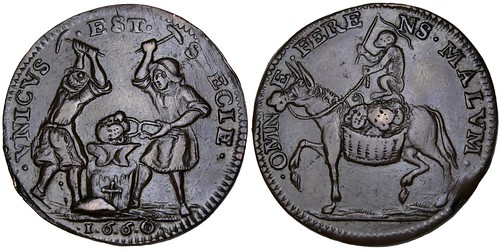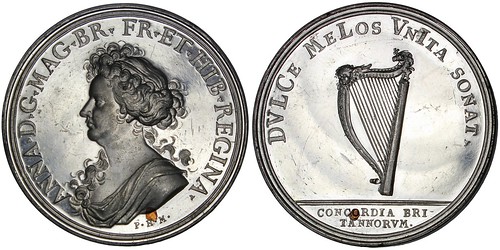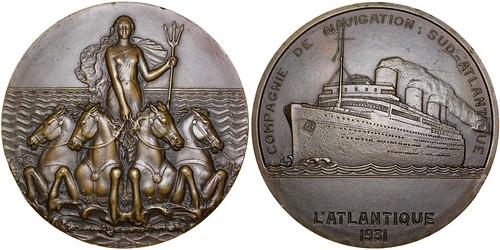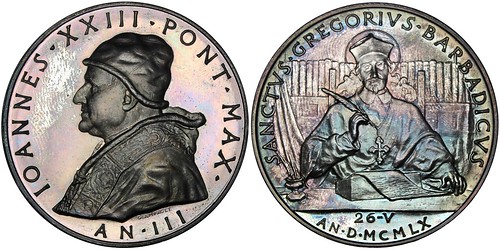
PREV ARTICLE
NEXT ARTICLE
FULL ISSUE
PREV FULL ISSUE
V25 2022 INDEX E-SYLUM ARCHIVE NUMISMAGRAM SELECTIONS: NOVEMBER 2022Jeremy Bostwick at Numismagram forwarded along these four highlights from his recent November addition of new material to his website. In addition to the items below, there are some attractively toned German medals, some Hungarian medical-themed medals, and a small-sized Betts medal in silver relating to the Treaty of Hubertusburg and end of the French & Indian War. For all of the new items, please visit https://www.numismagram.com/inventory. -Editor 102097 | FRANCE. "Conjugal Duties" Trials/Father Lustucru satirical copper Jeton. Issued 1660. On the topic of trials alleging impotence and promoting the "re-education" of "deviant" women by Father Lustucru (27mm, 6.71 g, 6h). VNICVS EST S[P]ECIE (he is unique in appearance...), two blacksmiths standing around anvil, both hammering and with one holding head of woman with pincers upon anvil / OMNE FERENS MALVM (...bearing all that is evil), monkey, holding whip and reins, riding donkey left and bearing basket filled with heads of women. Feuardent 9608; Neumann 39921; Mitchener 3489-91 (though erroneously described as a type pertaining to the many wars of Louis XIV). Choice Extremely Fine. Glossy brown surfaces, though a few minor edge bruises noted for completeness. $495. If one thinks that the explosion of reality TV of our era, with its poking and prodding into the private lives of some merely for the morbid curiosity of others, is actually anything new, it may come as a surprise that, in fact, it is not. In 17th century France, for instance, married couples were required, by law, to "perform their conjugal duties" with one another, submitting on demand for one partner to the other. In the instance of male impotence, such duties obviously created an impossible task for the husband, and one for which he could be tried for committing a larcenous act. The wife, who may wish to seek a divorce, could bring about a trial that would subject the couple to bedroom inquisitions and every type of examination to determine what exactly did, and did not, function properly. Needless to say, such trials were publicized, making them a voyeuristic forerunner to the most salacious stories of today. One such instance, and quite possibly the most famous, involved a French nobleman, René de Cordouan, the Marquis de Langey, who married Mademoiselle Marie de St Simon de Courtemer in 1653. Their marriage is described as happy for the first four years, though Madame Langey charged her husband with the claim of impotence in 1657, causing much in the way of examination into their intimate lives and bodies as well. The court found both husband and wife physically capable, though Madame Langey nevertheless insisted in the inadequacies of the Marquis, causing him to seek her damning allegations to be disproven so that his good name (and abilities) would be cemented in the eyes of the heavily invested public. His Trial by Congress, however, was not successful, as it was required that the couple submit to a private bathhouse for an evening, with a not-so-private jury of 15 individuals (five surgeons, five physicians, and five matrons) there to observe any fulfillment of conjugal duties. The Marquis, likely on account of the prying eyes all around, was unable, condemning his reputation and granting unto his wife a legal dissolution of their marriage. It is interesting to note that, years later, the Marquis would marry again, this time to Diana de Montault de Navaille, with whom he would father seven children. Given the nature of these allegations and subsequent trials, it seems obvious that some men become highly suspicious of "deviant" women who would use such a legal means as a way in which to seek a new marriage (and destroy their aura of masculinity). It was around this time that a mythical figure, Father Lustucru, appears in writings and engravings, with the goal of "re-educating" women who were seen as rebellious or hysterical to the patriarchy. This figure was presented in the setting of a blacksmith, with the severed heads of women being beaten with hammers upon anvils in an attempt to "cure" them of their wicked and wild ways. A simian-like creature, usually a monkey, was employed to ride a donkey, collecting the heads of various women in satchels and bringing them to Lustucru's forge for such "corrections," with a sign above his shop bearing some form of the phrase "the best woman is one without a head." That's harsh. An episode of history I missed out on learning about in school. -Editor
To read the complete item description, see:
102125 | GREAT BRITAIN. Queen Anne white metal Medal. Issued 1711. The Concord of Britain (44mm, 27.54 g, 12h). By P. H. Müller. ANNA D G MAG BR FR ET HIB REGINA, draped bust left / DVLCE MELOS VNITA SONAT (in unison she produces sweet harmony, [the larger letters indicating the date in a chronogram]), harp left, with top terminating in head of cherub; CONCORDIA BRI–/TANNORVM in two lines in exergue. Edge: Plain. MI 386/238; Eimer 451. Choice Mint State. Extremely brilliant and prooflike. $345. The concord represented on the reverse of this medal likely refers to the brief cessation in hostilities for Britons, in that there was an aim to end participation in the conflict involving so much of Europe, that of the War of Spanish Succession, upon the death of then-Emperor, Joseph I, in 1711. Beginning with the death of the childless Carlos II (Charles), the last of the Spanish Habsburgs, a power struggle ensued, with claimants hailing from France and Austria. Ultimately, the crown of Spain would pass to the Bourbons of France, with the new Spanish monarch (Felipe) renouncing his line in the French succession, while that of the Holy Roman Empire would stay with Habsburgs. Nice medal, and cool chronogram. -Editor
To read the complete item description, see:
102169 | FRANCE. Compagnie de Navigation Sud-Atlantique Art Deco bronze Medal. Issued 1931. Commemorating the maiden voyage of the "Atlantique" service line (68mm, 148.44 g, 12h). By L. Bazor in Paris. Venus, holding trident, in facing marine quadriga pulled by four sea horses / COMPAGNIE DE NAVIGATION SUD–ATLANTIQUE, perspective view from the right of the vessel breaking waves left; L'ATLANTIQUE / 1931 in exergue. Edge: «cornucopia» BRONZE. Choice Mint State. Charming brown surfaces, with some lighter highlights and pleasing relief; a few scattered marks are noted merely for completeness. An exceptional Art Deco design by an ever-popular medalist. Rare, especially this attractive. $365. The grandest and most luxurious passenger ship on the Europe–South America line, the Atlantique herself was in operation for little over two years, with her maiden voyage occurring in September/October 1930, and her demise—caused by a fire while in the English Channel—happening in January 1933. The Art Deco motif of this medal conveys the nature of the ship's interior design, which was heavily influenced by the style Great medal! -Editor
To read the complete item description, see:
102230 | ITALY. Vatican City. Pope Saint Ioannes XXIII silver Medal. Issued 1961/Year III. The canonization of Gregorio Barbarigo (44mm, 36.36 g, 12h). By P. Giampaoli in Rome. IOANNES • XXIII • PONT • MAX / AN • III, bust left, wearing camauro, mozzetta, and stole / SANCTVS • GREGORIVS • BARBADICVS, St. Gregorio seated facing at desk, wearing stole, biretta, and nimbus crown, and holding quill; in two lines in exergue, 26-V / AN • D • MCMLX. Edge: E•988. Bartolotti E961; Modesti 96; Rinaldi 155. Choice Gem Mint State. Highly brilliant and prooflike, with a deep iridescence spread mostly throughout. Includes box of issue. Mintage: 4,300. $225. A cardinal in the Roman Catholic Church who served as Bishop in both Bergamo and Padua, he was greatly revered for pastoral initiatives and scholarly learnings, as well as visitations within his ecclesiastic dominions. Given his strong standing within the Church hierarchy, he was considered a frontrunner to become Pope during the papal conclaves of 1689 and 1691. He was beatified in 1761 under Pope Clemens XIII (Clement), and was finally canonized, as celebrated on this medal, in 1960 under Pope Ioannes XXIII (John), who himself would later be canonized in 2014 under current Pope Franciscus (Francis). Nice medal. Bibliophiles will appreciate the bookshelves in the background. -Editor
To read the complete item description, see:
Wayne Homren, Editor The Numismatic Bibliomania Society is a non-profit organization promoting numismatic literature. See our web site at coinbooks.org. To submit items for publication in The E-Sylum, write to the Editor at this address: whomren@gmail.com To subscribe go to: https://my.binhost.com/lists/listinfo/esylum All Rights Reserved. NBS Home Page Contact the NBS webmaster 
|




